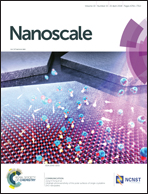Metal organic framework-derived CoPS/N-doped carbon for efficient electrocatalytic hydrogen evolution†
Abstract
Electrocatalytic hydrogen evolution has attracted a great deal of attention due to the urgent need for clean energy. Herein, we demonstrate the synthesis of ternary pyrite-type cobalt phosphosulphide (CoPS) nanoparticles supported on a nitrogen-doped carbon matrix, CoPS/N–C, through carbonization and subsequent phosphosulfurization of Co-based zeolitic imidazolate frameworks (ZIF-67), as promising hydrogen evolution reaction (HER) electrocatalysts in both acidic and alkaline solutions. The polyhedral structure of ZIF-67 can be well maintained in the as-prepared CoPS/N–C nanocomposites. In particular, CoPS/N–C provides a geometric catalytic current density of −10 mA cm−2 at overpotentials of −80 and −148 mV vs. a reversible hydrogen electrode (RHE) and a Tafel slope of 68 and 78 mV dec−1 in 0.5 M H2SO4 and 1 M KOH, respectively, which is superior to most of the transition metal phosphosulfide materials. This MOF-derived synthesis of a transition metal phosphosulfide supported heteroatom-doped carbon matrix provides a promising opportunity for the development of highly efficient electrocatalysts for renewable energy devices.



 Please wait while we load your content...
Please wait while we load your content...